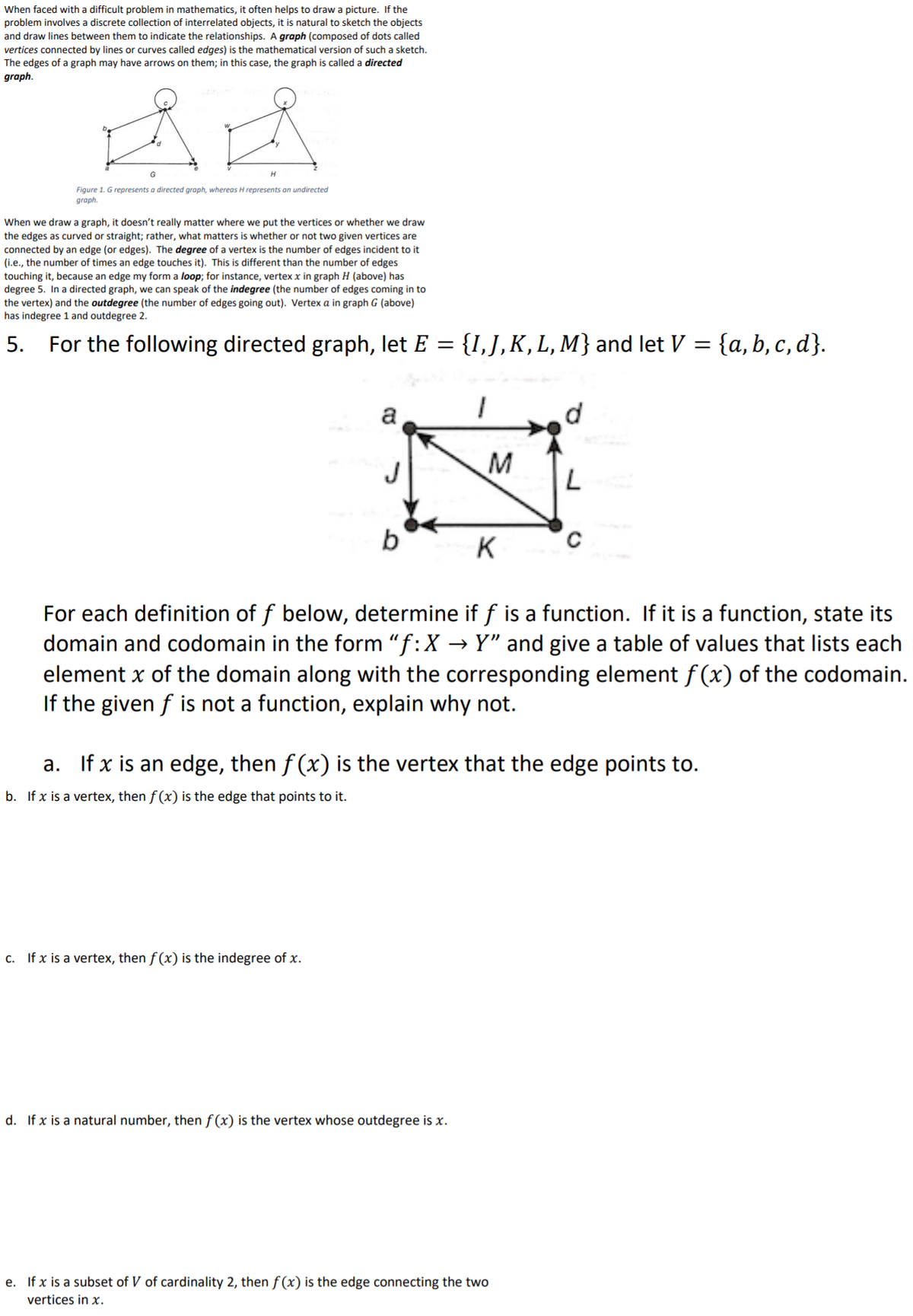When faced with a difficult problem in mathematics, it often helps to draw a picture. If the problem involves a discrete collection of interrelated objects, it is natural to sketch the objects and draw lines between them to indicate the relationships. A graph (composed of dots called vertices connected by lines or curves called edges) is the mathematical version of such a sketch. The edges of a graph may have arrows on them; in this case, the graph is called a directed graph. When we draw a graph, it doesn’t really matter where we put the vertices or whether we draw the edges as curved or straight; rather, what matters is whether or not two given vertices are connected by an edge (or edges). The degree of a vertex is the number of edges incident to it (i.e., the number of times an edge touches it). This is different than the number of edges touching it, because an edge my form a loop; for instance, vertex ? in graph ? (above) has degree 5. In a directed graph, we can speak of the indegree (the number of edges coming in to the vertex) and the outdegree (the number of edges going out). Vertex ? in graph ? (above) has indegree 1 and outdegree 2. For the following directed graph, let ? = {?,?,?, ?, ?} and let ? = {?, ?, ?, ?}. For each definition of ? below, determine if ? is a function. If it is a function, state its domain and codomain in the form “?:? → ?” and give a table of values that lists each element ? of the domain along with the corresponding element ?(?) of the codomain. If the given ? is not a function, explain why not. a. If ? is an edge, then ?(?) is the vertex that the edge points to. b. If ? is a vertex, then ?(?) is the edge that points to it. c. If ? is a vertex, then ?(?) is the indegree of ?. d. If ? is a natural number, then ?(?) is the vertex whose outdegree is ?. e. If ? is a subset of ? of cardinality 2, then ?(?) is the edge connecting the two vertices in ?.
When faced with a difficult problem in mathematics, it often helps to draw a picture. If the problem involves a discrete collection of interrelated objects, it is natural to sketch the objects and draw lines between them to indicate the relationships. A graph (composed of dots called vertices connected by lines or curves called edges) is the mathematical version of such a sketch. The edges of a graph may have arrows on them; in this case, the graph is called a directed graph.
When we draw a graph, it doesn’t really matter where we put the vertices or whether we draw the edges as curved or straight; rather, what matters is whether or not two given vertices are connected by an edge (or edges). The degree of a vertex is the number of edges incident to it (i.e., the number of times an edge touches it). This is different than the number of edges touching it, because an edge my form a loop; for instance, vertex ? in graph ? (above) has degree 5. In a directed graph, we can speak of the indegree (the number of edges coming in to the vertex) and the outdegree (the number of edges going out). Vertex ? in graph ? (above) has indegree 1 and outdegree 2.
For the following directed graph, let ? = {?,?,?, ?, ?} and let ? = {?, ?, ?, ?}.
For each definition of ? below, determine if ? is a function. If it is a function, state its domain and codomain in the form “?:? → ?” and give a table of values that lists each element ? of the domain along with the corresponding element ?(?) of the codomain. If the given ? is not a function, explain why not.
a. If ? is an edge, then ?(?) is the vertex that the edge points to.
b. If ? is a vertex, then ?(?) is the edge that points to it.
c. If ? is a vertex, then ?(?) is the indegree of ?.
d. If ? is a natural number, then ?(?) is the vertex whose outdegree is ?. e. If ? is a subset of ? of cardinality 2, then ?(?) is the edge connecting the two vertices in ?.

Trending now
This is a popular solution!
Step by step
Solved in 3 steps with 1 images









